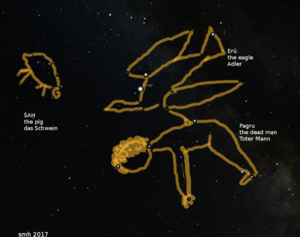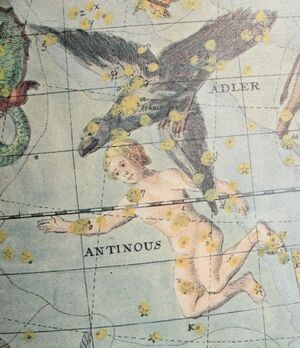Antinous: Difference between revisions
No edit summary |
|||
| Line 25: | Line 25: | ||
* Fortin |
* Fortin |
||
* Flamsteed |
* Flamsteed |
||
* ... |
|||
=== Weblinks === |
|||
* https://scilogs.spektrum.de/uhura-uraniae/sternbilder-der-adler-und-der-junge/ |
|||
==== References ==== |
|||
=== Suggested for ISC by === |
=== Suggested for ISC by === |
||
Revision as of 19:46, 19 February 2024
A "sub"-constellation (or asterism) Antinous was created by Ptolemy of Alexandria and published in the Almagest star catalogue 137 CE.
Name
Origin of the name/ story behind it
Antinous is the name of the favourit of Emperor Hadrian of Rome. When Hadrian was in Egypt, Antinous drowned in the Nile. It was unclear from the outset whether this was an accident, suicide or murder. Of course, it can no longer be clarified today. The fact is that he fell into the water, could not swim and drowned. The grief-stricken emperor then declared a state of mourning in the Roman Empire and a cult of veneration began: Hadrian had a temple built for Antinous in the city of Rome, Antinous games were held in Athens and the astronomer Ptolemy of Alexandria placed the name of the deceased among the stars by inventing a new constellation.
In the sky, Antinous was now part of the constellation of the Eagle, and in the Almagest the stars are listed as a separate group in this constellation.
Interestingly, the eagle is one of the "Greek" constellations that are taken directly from Babylonian uranography. The Babylonians also had a bird of prey, an eagle (or a vulture), in exactly the same place in the sky. Next to the Babylonian constellation Eagle is the Babylonian constellation The Corpse. Since the Almagest contains many Babylonian reminiscences (e.g. Babylonian eclipse observations are quoted), it could be that Ptolemy's new creation refers to the older Babylonian constellation and merely changes its name.
Our modern dedication
Ian Ridpath in his comprehensive book on Star Tales points out that the relationship of Antinous and Hadrian is not quite clear. He was definitely more than just a friend or consultant for the emperor. It may have been pederasty or a usual homosexual relation. Therefore, aiming at inclusion, astronomers of the 20th and 21st century prefer to use this asterism as a symbol of homosexuality in general (and not to link it with pederasty).
Reference(s)
Historical source
Almagest ...
Early Depiction(s)
- Bode 1781
- Fortin
- Flamsteed
- ...
Weblinks
References
Suggested for ISC by
Ian Ridpath and Susanne M Hoffmann (independently) for theta Aquilae (head of Ptolemy's figure)







